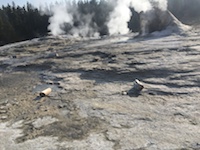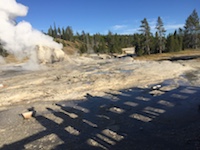After the midnight hot period, I decided that I needed to be out at least 4 hours later for the next activity. So I ended up waiting in the dark, with approaching lightning and rain for what turned out to be a bathtub. Quite disappointing, especially since the rain started as I untied my bike at Grotto. I went in for a couple hours of warming up, drying off, and maybe getting some sleep.
So it was a bit annoying to be waiting for the alarm to go off only to hear that another hot period had started about two hours later. Rushed out to see the end of a moderately strong hot period, and to get rained on again on the way back in.
So now it's time to not make any assumptions, unless willing to miss another hot period start. An hour later there was a long, 6min pause, which confirmed that suspicion. Going to wait until the next big hot period, then figure out how to get a break.
Four hours after that strong hot period, we got another long Bijou pause with visible Mastiff water. It barely qualified as a bathtub. A bit after five hours, we got a weak, Feather-only hot period. The only anomaly was that we did get Cave erupting weakly for a short time, despite none of the other vents, especially Feather's Satellite, doing much. But it was a sign I could head in for a bit.
Two hours later, having eaten and gotten cleaned up, I got back just in time for another long Bijou Pause. Forty-five minutes later, Bijou started having slowdowns, but nothing close to a real pause. Then, around the 70 minute mark, which seems common, a pause started,
This pause was slow to build. It seemed like all the other features were taking their time in getting started. It was four minutes before Feather finally started, and another twenty seconds before Mastiff started to overflow. It took Feather's satellite almost 2-1/2 minutes to get to overflow, a minute after Cave started. Mastiff didn't boil all that high, either. But that's when the fun began.
When Mastiff dropped, and Bijou came on, Feather didn't quit. When Posthole came on, Giant started surging. The surging was small at first, but the water level was high. Often we could see the boil up in the vent before and after a surge. Over the next few minutes, they just kept getting better. I commented that if it didn't erupt this time, it was going to be a while until the next attempt at erupting.

Then we got a massive surge well above the cone, one pouring out water. Two more even larger surges and Giant was in full eruption. It was windy, but the direction of the wind was away from us. It pushed the water column to the northwest, such that those of us standing at the northern corner of the Cage had to look straight up to see the tops of the jets. It was also mostly sunny, so back a ways, on the boardwalk, there were rainbows stretching from Giant northward.
After the first minute or so, I rushed back to the baseline to get a height. I got 85% of 60meters, which comes out to 51meters, or only 167 feet. Like the pervious eruption, even with the wind pushing the top of the column away, that seems way too short. It sure felt much higher than that.
As I went to get the height measurements, I also noticed that Grand had just started erupting. I don't think many people cared about it. But because a lot of people had headed up there for that eruption before the hot period started, there were a lot of gazers on the boardwalk back there instead of being in the cage.
The end of the eruption seemed to drag out, making it hard to tell when the end finally came, and making it one of the longer ones in a while. It was a great eruption under excellent conditions.
While waiting in the morning, I got to see a private tour-group get part of their talk in the cage. There were two guides, and instead fo talking about Giant, the subjects were The Gumper (over at Mud Volcano) and how to properly visit a backcountry thermal area. The first guid made it sound like The Gumper is way off and inacessible. Back in 1983, when I went there a few times, the hardest part of getting there was not being seen when you left the established trails at Mud Volcano.
The second complained how he was no longer able to take people to see Tomato Soup Spring up Rabbit Creek as a group, but people were able to go up by themselves. That got me to thinking...
I disagree with the NPS closures of all these areas, but I also thought that it was people like him who caused a lot of the problems. Most of those people wouldn't be hiring him if they were willing or able to visit the thermal areas on their own. Most of those people probably had never see a geyser or mud pot or large hot spring before. Why do they need to see some obscure feature like Tomato Soup Spring? (One I've never visited, either). Because, thanks to things like "social media", people have gotten the idea that they don't need to spend any time to become familiar with the common features and activities, but must jump straight into the rare and unusual and "unique". Gotta fill in that bucket list, even if you have no idea why those features are on the bucket list you are required to fill in "before you die."
Besides, what good is a guide if all it can show you is what you'd find on your own, or could read in a book? The guide needs to be able to take people back to rare and unusual areas (and help ruin them in the process) in order to justify getting paid. (The same goes for the "Secrets of..." type books.)
(As for the closures and what to do about them, I have some ideas based on my experiences in NPS units in Utah. They could work, but I don't know if the NPS here could be trusted to do it right.)

